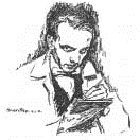Sátori Lipót
1899 - 1943

Sátori, Lipót
Sátori (or Sátory) was an important graphic artist, who worked primarily during the 1910s and 1920s. He is famous for his film posters.
Sátori was born Lipót Schneider, his family was Jewish. He studied at the School for Applied Arts (Iparművészeti Iskola) in Pest. His first posters appeared in 1917. During these early years he was working regularly for the Urania Film Theatre (one of the greatest cinemas in Pest). Sátori soon became a famous film poster designer, because of his unique talent of summarizing the movies by very attractive compositions.
During World War I, he was designing posters for propagandistic war films, while in 1919, he created a poster for the new Soviet regime.
Between 1918 and 1919, he opened a design studio with Imre Földes, and they collaborated on many poster designs, mainly, but not exclusively designing movie posters. With the first golden age of the cinema, in the 1920s and 1930s, he had many commissions. As Földes was no longer living in Budapest, Sátori worked alone, or together with Gyula Fejes. He also created book illustrations.
The style of his early posters fit into the decorative, Art Noveau tendencies of the 1910s. These works are rather realistic and narrative. He usually portrays a character from the movie on his posters, or depicts a typical scene. His works from the 1920s and 1930s represent a beautiful Art Deco style. He uses big, coloured fields and his lines got stronger than before.
Sátori’s favourite motive is the woman – usually the lead actress of the movie. His woman figures are demonic and erotic. He often uses dramatic lighting effects in his works, which originates from the movies of the age. Some of his posters represent the star’s large, scary or erotic portrait.
It is hard to separate his style from his friend and colleague, Imre Földes. We can say, that while Földes’s works are based on drawing, Sátori’s style is more painting-like, his posters are more expressive. He often uses strong, vivid colours, and expressive, dynamic forms. His style fits perfectly to the visual world of the silent movies of the era. .

